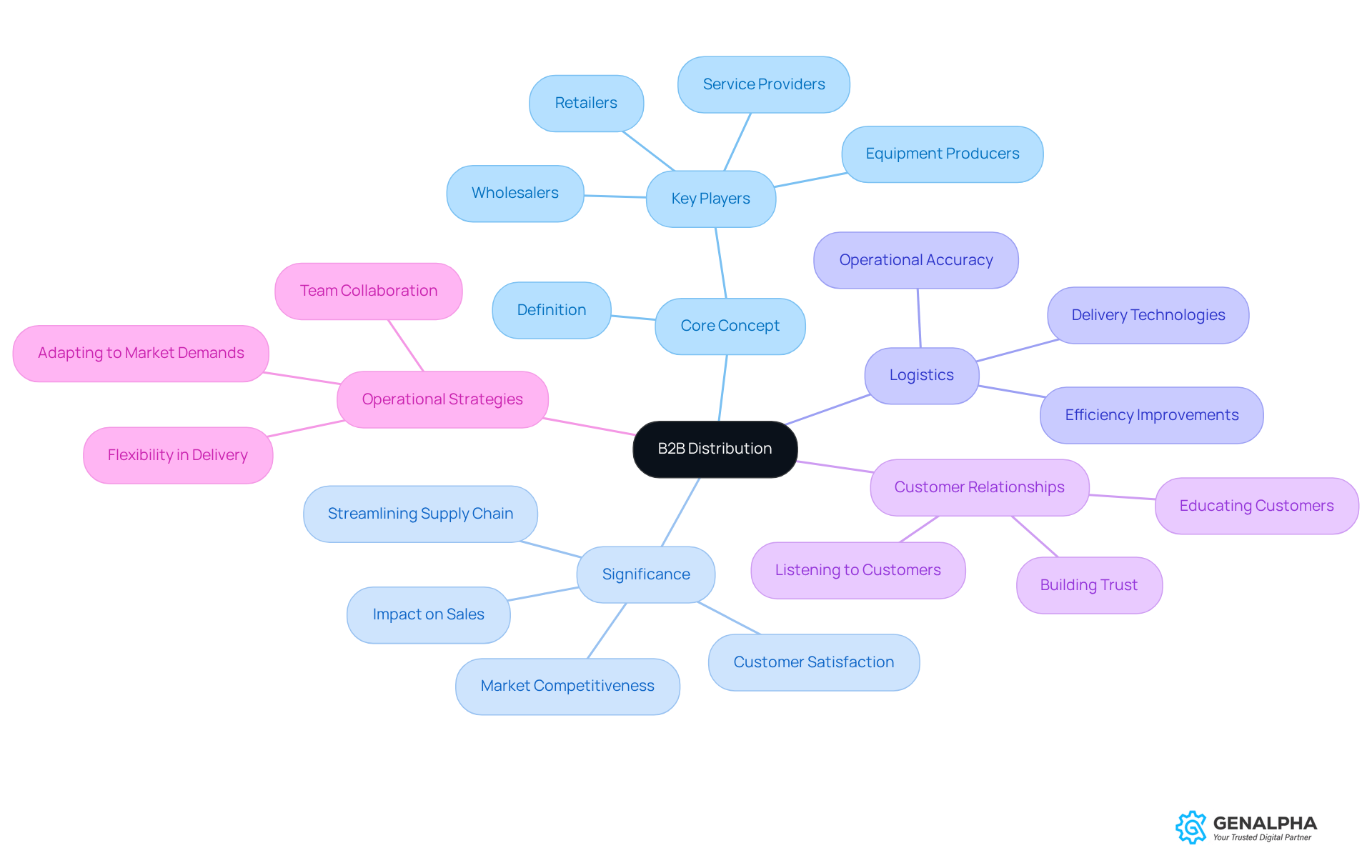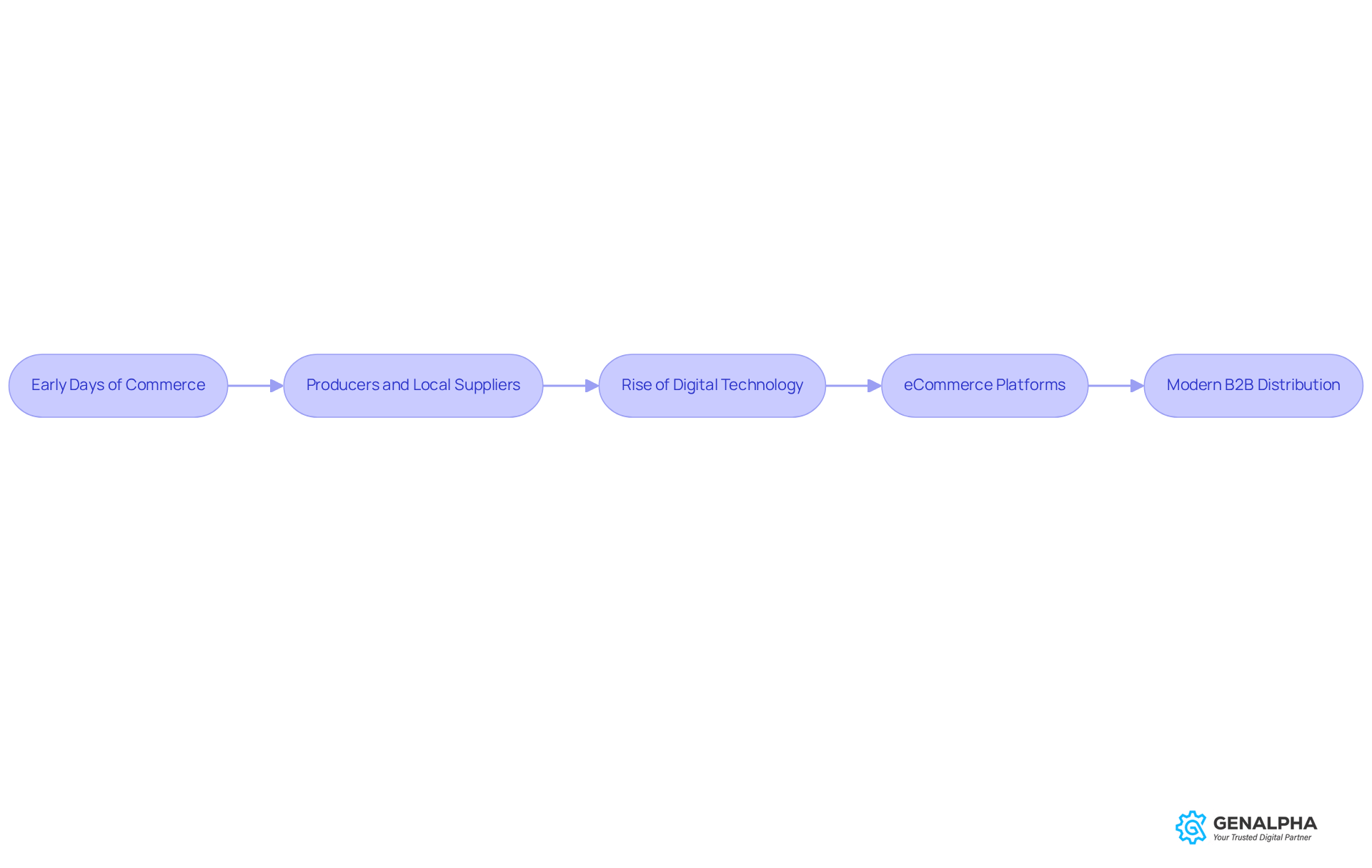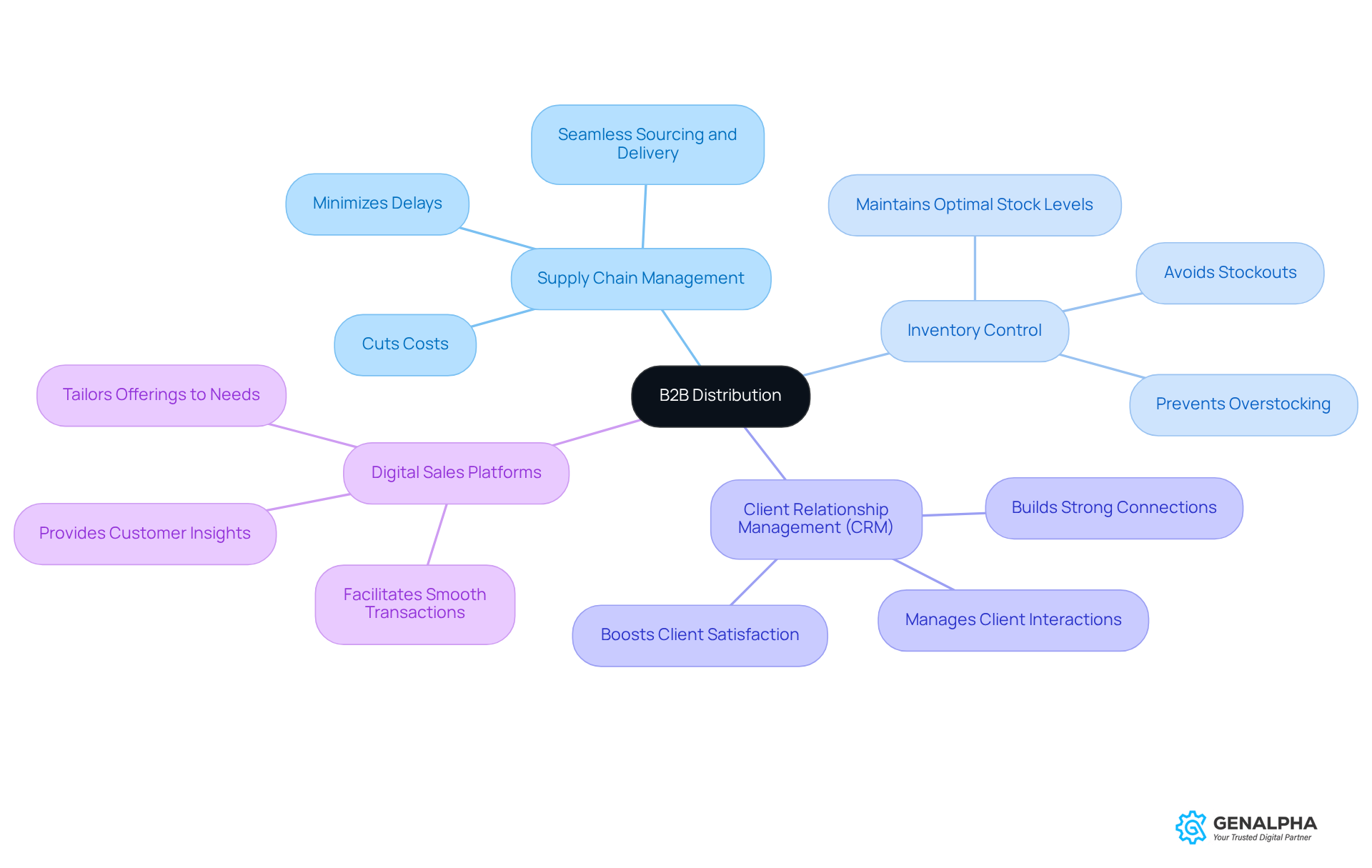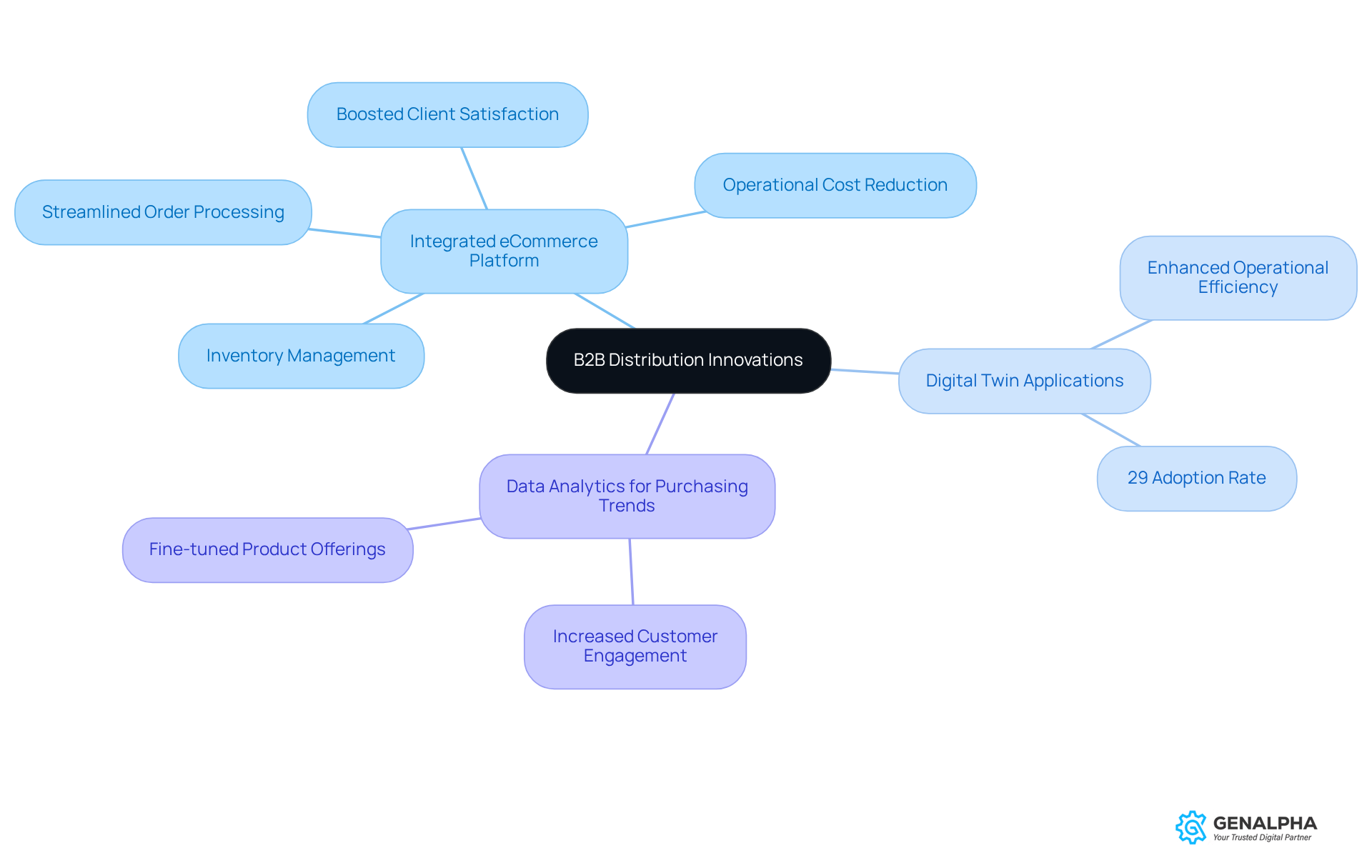Overview
The article "4 Key Insights into B2B Distribution for Equipment Manufacturers" dives into why B2B distribution matters so much for equipment manufacturers. It’s all about boosting operational efficiency and keeping customers happy. Have you ever thought about how digital solutions, smart supply chain management, and data analytics can really change the game? By embracing these tools, manufacturers can revamp their distribution strategies, which helps them respond better to market demands and build stronger relationships with their customers.
Imagine this: you’re a manufacturer trying to keep up with the fast-paced market. Leveraging technology not only makes your operations smoother but also enhances how you connect with your customers. It’s like having a secret weapon in your back pocket! So, what’s holding you back from exploring these innovative solutions? Let’s take a closer look at how these insights can make a real difference in your business.
In conclusion, understanding the impact of B2B distribution is crucial. By adopting these strategies, you can not only improve your responsiveness but also foster lasting customer relationships. Are you ready to take action and transform your distribution approach?
Introduction
B2B distribution is a key player in today’s commerce, connecting the supply chains that power industries all over the globe. For equipment manufacturers, grasping the ins and outs of this distribution model can boost not just operational efficiency but also customer satisfaction and competitive advantage. But here’s the kicker: as digital transformation shakes things up, manufacturers are left pondering a crucial question. How can they tweak their strategies to harness new technologies and meet the changing needs of their clients?
Let’s dive into this together and explore how adapting to these shifts can lead to exciting opportunities!
Define B2B Distribution: Core Concept and Significance
, also known as , focuses on how goods and services are sold from one business to another instead of to individual consumers. Think of equipment producers supplying machinery, tools, and aftermarket components to various enterprises like wholesalers, retailers, and service providers. The magic of [B2B distribution](https://blog.genalpha.com/5-strategies-for-effective-bom-management-in-manufacturing) is in its ability to streamline , ensuring that products get to the right businesses at the right time. This is crucial for producers because it directly impacts their sales, , and competitiveness in the market.
Industry leaders often highlight how effective B2B delivery can completely change a manufacturer's sales game. As one anonymous source put it, "A is a force that no rival can weaken," showing just how important collaboration is in supply strategies. Plus, statistics reveal that companies using see a big boost in operational accuracy and efficiency—key factors for staying ahead of the competition.
When we look at [supply chain operations](https://blog.genalpha.com/10-strategies-for-effective-product-data-management-in-manufacturing), B2B distribution isn't just about logistics; it's a strategic element that enhances responsiveness to market demands. Remember, "Customers today are more sophisticated and frequently more demanding," which means producers need to tweak their delivery strategies to meet these evolving expectations. This flexibility is vital for building strong and driving ongoing growth in a competitive landscape. So, how are you planning to adapt your delivery strategies to keep pace with these changes?

Explore the Evolution and Context of B2B Distribution
Have you ever thought about how B2B supply chains came to be? They actually trace back to the early days of commerce, when producers relied on local suppliers to reach broader markets. Fast forward a few decades, and things have changed quite a bit, especially with the rise of digital technology. With booming, producers can now sell directly to businesses online, transforming traditional supply routes.
This shift has brought a wave of benefits: think , reduced costs, and improved . Nowadays, B2B distribution focuses primarily on . Integrated eCommerce platforms and data analytics are at the forefront of B2B distribution, assisting producers in fine-tuning their logistics strategies and enhancing client experiences.
So, how can you leverage these digital tools in your own supply chain? It’s all about embracing the change and optimizing your approach to stay ahead in this evolving landscape.

Identify Key Components and Characteristics of B2B Distribution
When we think about b2b distribution, several essential elements come to mind, including:
Imagine a world where products are sourced, stored, and delivered seamlessly—this is what effective supply chain management achieves. It minimizes delays and cuts costs, making life easier for everyone involved.
Now, consider inventory control. It’s all about keeping the right stock levels—nobody wants to deal with overstocking or running out of products at the wrong time.
And let's not forget about CRM systems. They’re vital for managing client interactions, helping producers build strong connections and boost client satisfaction.
Lastly, , like , are game-changers. They facilitate smooth transactions and provide valuable insights into customer behavior. This means producers can tailor their offerings to meet specific needs.
So, how are you leveraging these tools in your own ?

Examine Real-World Examples of B2B Distribution
Have you noticed how many producers are really stepping up their game with innovative ? It’s pretty impressive! Take, for example, a well-known equipment manufacturer that rolled out an . This move didn’t just streamline order processing and inventory management; it also cut down on operational costs and . Customers now enjoy and faster delivery times.
And here’s something interesting: industry insights reveal that 29% of global companies are now adopting in manufacturing. This trend highlights how technology can really enhance .
Another great example comes from a distributor that tapped into to figure out purchasing trends among their clients. This insight allowed them to fine-tune their product offerings and ramp up . As Ryan Tavares puts it, "Enhance manufacturing efficiency with automated assembly tools, including robots, AGVs, vision systems, and component feeding solutions."
These examples really show how can drive competitive advantages in B2B distribution. So, how are you thinking about using technology in your own operations?

Conclusion
B2B distribution plays a crucial role in the engine of modern business, especially for equipment manufacturers. It’s all about how goods and services are exchanged between businesses, highlighting the need for efficient supply chains, strategic partnerships, and tech integration. For manufacturers aiming to boost their competitiveness and success, adapting to market demands and evolving customer expectations is key.
Throughout this article, we’ve explored essential insights into B2B distribution, tracing its journey from traditional supply chains to the digital solutions we see today. We’ve highlighted the importance of effective supply chain management, inventory control, and client relationship management, along with the game-changing role of digital sales platforms. Real-world examples have shown us how innovative strategies and embracing technology can lead to better operational efficiency and happier customers.
These insights underscore how vital it is for equipment manufacturers to embrace change and leverage technological advancements in their B2B distribution strategies. As the landscape keeps shifting, it’s important for manufacturers to proactively adapt their approaches. Are you ready to respond to market dynamics and customer needs? By doing so, you can enhance your operational effectiveness and secure a competitive edge in this ever-evolving business world.
Frequently Asked Questions
What is B2B distribution?
B2B distribution, or business-to-business distribution, refers to the process of selling goods and services from one business to another, rather than to individual consumers. It involves equipment producers supplying machinery, tools, and components to various enterprises like wholesalers, retailers, and service providers.
Why is B2B distribution important?
B2B distribution is crucial because it streamlines supply chain operations, ensuring that products reach the right businesses at the right time. This directly impacts producers' sales, customer satisfaction, and competitiveness in the market.
How can effective B2B delivery impact a manufacturer’s sales?
Effective B2B delivery can significantly enhance a manufacturer’s sales by fostering trust and collaboration in partnerships, which are essential for a strong supply strategy. This can lead to improved operational accuracy and efficiency.
What role does technology play in B2B distribution?
Companies that utilize specialized delivery technologies experience a notable increase in operational accuracy and efficiency, which are vital for maintaining a competitive edge in the market.
How does B2B distribution relate to market demands?
B2B distribution is not just about logistics; it is a strategic element that enhances responsiveness to market demands. Producers must adapt their delivery strategies to meet the increasingly sophisticated and demanding expectations of customers.
Why is flexibility important in B2B distribution?
Flexibility in B2B distribution is essential for building strong customer relationships and driving ongoing growth in a competitive landscape, as it allows producers to adapt to changing market conditions and customer needs.




